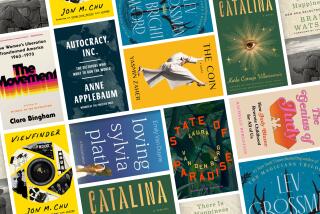Book review: ‘Angelology: A Novel’ by Danielle Trussoni
Danielle Trussoni is the latest author to sidle up to the dessert cart for a slice of the Dan Brown pie. What Brown (“The Da Vinci Code,” etc.) has done with demons, Catholic and Masonic secret societies, symbols and long-buried scandals, Trussoni aims to do with the evil spawn of rebel angels who once mated with humans. These hybrid beings are 7 feet tall and lack belly buttons; some have wings. But they manage to live among us undetected, save for a semi-Catholic secret society of “angelologists” who keeps tabs on them.
Trussoni’s first book, “Falling Through Earth” -- a memoir about growing up with her damaged father, who served as a “tunnel rat” in the Vietnam War -- was a serious one; it made the New York Review of Books’ Ten Best list for 2006. That her fiction debut, “Angelology,” should be a commercial exercise in fantasy is disappointing -- if perfectly understandable, given current market conditions.
How do you persuade people to take the unserious seriously? The keys, as any cult leader or drill sergeant can tell you, are isolation and saturation -- shut out the real world until it becomes unreal and hammer the message home for all you’re worth.
Thus, the longer and slower-moving a fantasy novel is, the better.
Trussoni has no trouble with the saturation part. She pads her narrative with arcane theology, faux science, monastic ritual and plenty of puzzles to solve. She’s good at evoking atmosphere and mood, details of architecture and clothing, shifts in the weather. But in the quest for isolation, she tries to do something very hard indeed: to persuade us -- for as long as the book lasts, anyhow -- that World War II is little more than a sideshow to the Second Angelogical Expedition of 1943.
The First Expedition, led by the Venerable Clematis of Thrace (now Bulgaria), takes place in the 10th century. It finds the original rebel crew imprisoned by God in a cave called the Devil’s Throat in the Rhodope Mountains. The angels, who play seductive music on the lyre of Orpheus -- mythological visitor to the Underworld -- are beautiful, treacherous, radioactive. Horribly burned, Clematis dies, leaving a fragmentary account that baffles angelologists for the next thousand years.
In 1943, hindered by the German occupation of France but lavishly financed by Abigail Rockefeller, who founded the Museum of Modern Art in New York, a team from an angelological academy in Paris locates the cave again. Its mission is to get hold of the lyre before the Nephilim, or hybrids, do, because the music, if let loose on Earth, could wreak even more havoc than the Nazis have.
In 1999, at an upstate New York convent, the librarian, Sister Evangeline, daughter and granddaughter of angelologists, gets an unusual request from a young art historian, V.A. Verlaine: He wants to examine Mrs. Rockefeller’s letters to the convent. Verlaine is unwittingly working for Percival Grigori, one of the most powerful Nephilim. A mysterious disease is shriveling the hybrids’ wings, and Grigori, believing the lyre can cure them, will stop at nothing to find its hiding place.
Soon Evangeline and Verlaine are running for their lives. Trussoni’s descriptive skills are strong enough to generate a fair amount of suspense, despite wooden, humorless dialogue (the serious can admit almost any amount of humor, but the unserious doesn’t dare) and clumsy action sequences that climax in a showdown on the ice-skating rink in Rockefeller Center. The ending is a shocker: a romantic fizzle that’s explainable only if -- and we don’t have to be Dan Brown code-breakers to see it coming -- a sequel is on the way.
Harris is a critic and the author of the novel “The Chieu Hoi Saloon.”
More to Read
Sign up for our Book Club newsletter
Get the latest news, events and more from the Los Angeles Times Book Club, and help us get L.A. reading and talking.
You may occasionally receive promotional content from the Los Angeles Times.






